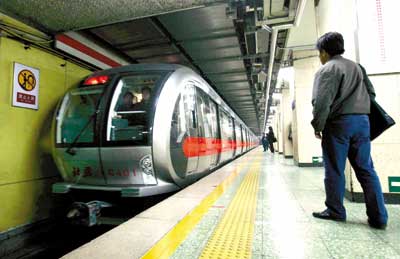(Ecns.cn) -- With nearly 30 cities, small and large, aspiring to build their rapid transit railway networks, China is now having a subway construction fever across the country. More than 110 metro lines are being constructed or in the planning stages, despite the high costs.
Competition is fierce among Chinese cities over subway construction. Most local governments want miles of subway line, yet under the shortest possible construction time. However, under such a background of hasty construction, problems such as frequent operating accidents, planning irregularities, and deficit difficulties have brought many hidden problems to the forefront.
In some medium-sized cities where the roads are enough for the traffic, it is even wasteful to build subway lines. But it is estimated that the number of subway lines in operation will increase from 10 in 2006 to 86 by 2015.
Frequent accidents
Xiao Chen (alias) is a typical office worker in Guangzhou who rushes between different subway stations every day. From the small front window of the locomotive, one can see the deep and dark tunnel ahead, and Xiao Chen said this is his favorite form of "entertainment" on the way to work.
However, a subway accident that happened some days ago made Xiao Chen realize that the trains he rides every day may suddenly become life-claiming mechanical devices. He recalled that there was a signal failure along Guangzhou's subway Line 2 on the morning of August 15, causing delays and even temporary shutdowns. At that time, Xiao Chen happened to be in the tube, and he felt a little bit scared. He said, "Our train stopped in the tunnel for four or five minutes, and I thought of the high-speed train tragedy on July 23, 2011. There was a minor panic for a while."
Similar accidents happened very frequently to subway lines across the country. Escalator malfunctions, circuit breakdowns, trains moving in the wrong direction, and door failures are among the most common problems.
On the morning of July 5 in Beijing, a rising escalator suddenly changed direction at the Beijing Zoo Station on subway Line 4, leaving a 13-year-old boy dead and 30 injured.
On the evening of July 25 in Shenzhen, a train on metro Line 4 made an emergency brake stop when running between the Exhibition Center Station and the Civic Center Station. An investigation showed that one door of the metro train opened by 10 centimeters for about one second, during which, the train's security switch immediately functioned by closing the door and making an emergency brake for the train. The train's service was affected for about one minute.
On the evening of July 28 in Shanghai, a train on subway Line 10 ran in the opposite direction because of a mix-up in communication during the upgrade and debugging of the train control signal.
On August 8 in Shenzhen, a train on metro Line 4 stopped service for over an hour because of its failure to start again.
As a means of transportation and with a dense population using it every day, many people have started to worry about and doubt the safety of the country's subways.
In fact, experts have been warning about the possibility of problems caused by such hasty subway construction for a while now. They worry that different signal controlling systems and train models might result in the instability of subway performance.


















